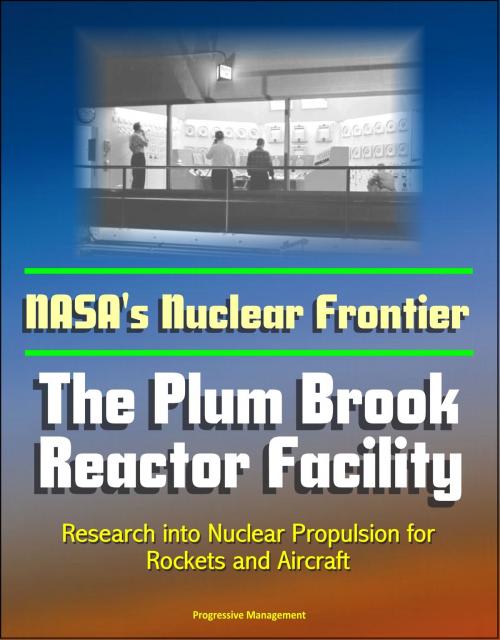NASA's Nuclear Frontier: The Plum Brook Reactor Facility - Research into Nuclear Propulsion for Rockets and Aircraft
Nonfiction, Science & Nature, Technology, Aeronautics & Astronautics, Science, Physics, Astrophysics & Space Science| Author: | Progressive Management | ISBN: | 9781310397004 |
| Publisher: | Progressive Management | Publication: | September 5, 2014 |
| Imprint: | Smashwords Edition | Language: | English |
| Author: | Progressive Management |
| ISBN: | 9781310397004 |
| Publisher: | Progressive Management |
| Publication: | September 5, 2014 |
| Imprint: | Smashwords Edition |
| Language: | English |
This official NASA history document - converted for accurate flowing-text e-book format reproduction - provides a fascinating history of NASA's nuclear research on propulsion at the Plum Brook reactor facility in Sandusky, Ohio. This book is a visual history of the Plum Brook reactor, including numerous images and captions, a narrative history, and selected primary documents. It begins with the acquisition of the Plum Brook farmland by the government at the start of World War II and discusses its use as a significant ordnance works for the war effort. At the same time, scientists worldwide were making tremendous progress on a roughly fifty-year investigation of the mysterious world inside the atom and the enormous reserve of power it appeared to contain. This work culminated in the atomic bomb. After the war, as Plum Brook's ordnance factories went silent, scientists continued their pursuit of nuclear knowledge by constructing test reactors. One specific aim for this research in the 1950s was to build a nuclear-powered airplane. To support this effort, in 1956 NASA's predecessor, the National Advisory Committee for Aeronautics (NACA), began to design and build a massive test reactor at Plum Brook. By the time the reactor was completed in 1961, President Kennedy had suspended the nuclear aircraft program for safety and technical reasons. However, in its place he advocated an even bolder plan—a nuclear rocket. The Plum Brook Reactor Facility became one of the primary research facilities to test materials for this rocket. Working with contractors from Lockheed, Westinghouse, General Dynamics, and General Electric, scientists and engineers conducted ground breaking nuclear experiments.
Despite the promise of their work, many of the experiments were never concluded. In 1973, just over a decade after Kennedy first extolled the nuclear rocket's importance, the project shared the fate of the nuclear airplane. In the post-Apollo era, NASA terminated costly, long-term, nonreusable projects like the nuclear rocket in favor of programs that appeared to have greater immediate payoff like the Space Shuttle. Two weeks after Apollo's last mission, Plum Brook was ordered to shut down its reactor. The entire facility was maintained in a standby mode (under a "possess but do not operate" license) for nearly a quarter century. In 1998, a decommissioning plan was formulated to demolish the reactor piece by piece, until nothing would be left but bare land, suitable once again for farming. Despite now being closed for over thirty years, it remains the eighth-largest test reactor that the United States has ever built.
This official NASA history document - converted for accurate flowing-text e-book format reproduction - provides a fascinating history of NASA's nuclear research on propulsion at the Plum Brook reactor facility in Sandusky, Ohio. This book is a visual history of the Plum Brook reactor, including numerous images and captions, a narrative history, and selected primary documents. It begins with the acquisition of the Plum Brook farmland by the government at the start of World War II and discusses its use as a significant ordnance works for the war effort. At the same time, scientists worldwide were making tremendous progress on a roughly fifty-year investigation of the mysterious world inside the atom and the enormous reserve of power it appeared to contain. This work culminated in the atomic bomb. After the war, as Plum Brook's ordnance factories went silent, scientists continued their pursuit of nuclear knowledge by constructing test reactors. One specific aim for this research in the 1950s was to build a nuclear-powered airplane. To support this effort, in 1956 NASA's predecessor, the National Advisory Committee for Aeronautics (NACA), began to design and build a massive test reactor at Plum Brook. By the time the reactor was completed in 1961, President Kennedy had suspended the nuclear aircraft program for safety and technical reasons. However, in its place he advocated an even bolder plan—a nuclear rocket. The Plum Brook Reactor Facility became one of the primary research facilities to test materials for this rocket. Working with contractors from Lockheed, Westinghouse, General Dynamics, and General Electric, scientists and engineers conducted ground breaking nuclear experiments.
Despite the promise of their work, many of the experiments were never concluded. In 1973, just over a decade after Kennedy first extolled the nuclear rocket's importance, the project shared the fate of the nuclear airplane. In the post-Apollo era, NASA terminated costly, long-term, nonreusable projects like the nuclear rocket in favor of programs that appeared to have greater immediate payoff like the Space Shuttle. Two weeks after Apollo's last mission, Plum Brook was ordered to shut down its reactor. The entire facility was maintained in a standby mode (under a "possess but do not operate" license) for nearly a quarter century. In 1998, a decommissioning plan was formulated to demolish the reactor piece by piece, until nothing would be left but bare land, suitable once again for farming. Despite now being closed for over thirty years, it remains the eighth-largest test reactor that the United States has ever built.















